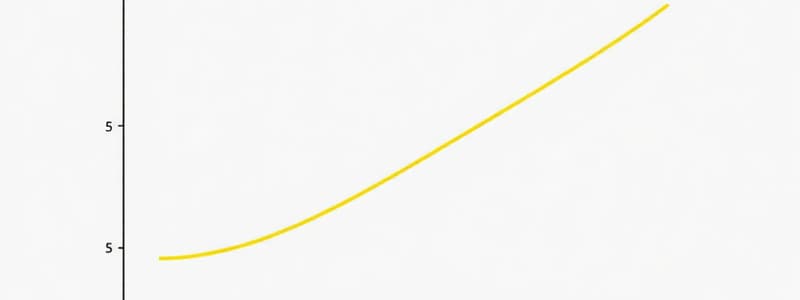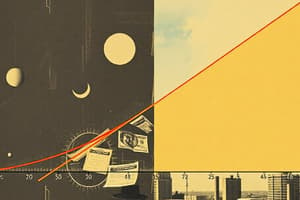Podcast
Questions and Answers
According to the IS curve framework, which component of aggregate expenditure is considered the MOST sensitive to changes in the interest rate?
According to the IS curve framework, which component of aggregate expenditure is considered the MOST sensitive to changes in the interest rate?
- Consumption
- Investment (correct)
- Government purchases
- Net exports
If the central bank increases the money supply, fine-tuning the overnight money market, what is the expected impact on the real interest rate, assuming inflation expectations remain constant?
If the central bank increases the money supply, fine-tuning the overnight money market, what is the expected impact on the real interest rate, assuming inflation expectations remain constant?
- The real interest rate will decrease. (correct)
- The real interest rate will increase.
- The real interest rate will remain unchanged.
- The real interest rate may increase or decrease unpredictably.
Which of the following scenarios would MOST likely cause a shift of the IS curve to the left?
Which of the following scenarios would MOST likely cause a shift of the IS curve to the left?
- A reduction in interest rates by the central bank.
- An increase in government purchases due to a new infrastructure project.
- Increased global demand for domestic exports.
- A decrease in consumer confidence leading to less spending. (correct)
If the central bank's inflation target is 2% and current inflation is 3%, how would the central bank MOST likely adjust the nominal interest rate according to a simple Monetary Policy Rule?
If the central bank's inflation target is 2% and current inflation is 3%, how would the central bank MOST likely adjust the nominal interest rate according to a simple Monetary Policy Rule?
What is the MOST likely effect of a significant increase in the risk premium on the real interest rate relevant for aggregate demand?
What is the MOST likely effect of a significant increase in the risk premium on the real interest rate relevant for aggregate demand?
Assuming other factors remain constant, how does a decrease in the cost of consumption loans typically affect consumption?
Assuming other factors remain constant, how does a decrease in the cost of consumption loans typically affect consumption?
If a country experiences increased demand for its currency, what is the MOST likely impact on its net exports, assuming other factors remain constant?
If a country experiences increased demand for its currency, what is the MOST likely impact on its net exports, assuming other factors remain constant?
Which of the following fiscal policies would be MOST effective in shifting the IS curve to the right during a recession?
Which of the following fiscal policies would be MOST effective in shifting the IS curve to the right during a recession?
How does an increase in the 'term spread' typically affect economic activity?
How does an increase in the 'term spread' typically affect economic activity?
What is the MOST likely impact of automatic stabilizers, such as unemployment benefits, on the IS curve during an economic downturn?
What is the MOST likely impact of automatic stabilizers, such as unemployment benefits, on the IS curve during an economic downturn?
Which of the following is the MOST likely consequence of a credit crunch on the liquidity premium, and how does this affect the IS-MP model?
Which of the following is the MOST likely consequence of a credit crunch on the liquidity premium, and how does this affect the IS-MP model?
What is the MOST direct impact of increased business confidence on the IS curve?
What is the MOST direct impact of increased business confidence on the IS curve?
In the context of the IS-MP model, what is the primary short-run effect of expansionary monetary policy?
In the context of the IS-MP model, what is the primary short-run effect of expansionary monetary policy?
How do increased trade barriers in foreign markets typically affect a country's net exports and the IS curve?
How do increased trade barriers in foreign markets typically affect a country's net exports and the IS curve?
If lenders expect higher default rates on loans in the near future, what is the MOST likely impact on longer-term interest rates?
If lenders expect higher default rates on loans in the near future, what is the MOST likely impact on longer-term interest rates?
What is the MOST direct effect of reduced government assistance on the IS curve, assuming other factors remain constant?
What is the MOST direct effect of reduced government assistance on the IS curve, assuming other factors remain constant?
How does easier lending standards and increased cash reserves in the banking system PRIMARY affect the IS curve?
How does easier lending standards and increased cash reserves in the banking system PRIMARY affect the IS curve?
When there is inflation below the target, according to the monetary policy rule, what action would the central bank MOST likely take?
When there is inflation below the target, according to the monetary policy rule, what action would the central bank MOST likely take?
What is the effect of increased taxes, assuming other factors remain constant, on the IS curve?
What is the effect of increased taxes, assuming other factors remain constant, on the IS curve?
What will an increase in global GDP growth MOST likely do to a country's net exports and the IS curve?
What will an increase in global GDP growth MOST likely do to a country's net exports and the IS curve?
Flashcards
Aggregate Demand
Aggregate Demand
Total demand for goods and services in an economy at a given price level.
The IS Curve
The IS Curve
The IS curve represents the relationship between interest rates and the level of income or output in the goods and services market.
Interest Rate Sensitivity of Demand
Interest Rate Sensitivity of Demand
How much demand changes in response to changes in interest rates.
Aggregate Expenditures (Demand)
Aggregate Expenditures (Demand)
Signup and view all the flashcards
Consumption
Consumption
Signup and view all the flashcards
Investment
Investment
Signup and view all the flashcards
Government Purchases
Government Purchases
Signup and view all the flashcards
Net Exports
Net Exports
Signup and view all the flashcards
Monetary Policy Rule
Monetary Policy Rule
Signup and view all the flashcards
Term Premium/Interest Rate Risk
Term Premium/Interest Rate Risk
Signup and view all the flashcards
Study Notes
Aggregate Demand
- Aggregate expenditures (demand) are a function of the interest rate
IS Curve
- Production (Y) equals the sum of consumption (C), investment (I), government purchases (G), and net exports (NX)
- Consumption and investment are inversely related to the interest rate (r)
- Government spending and net exports are also inversely related to the interest rate
- Higher interest rates increase the cost of consumption loans but increases return on saving (opportunity cost)
- Investment is the most interest rate sensitive due to returns being discounted at a higher rate when interest rates increase
- Government purchases are the least interest rate sensitive because the interest payments on the debt go up
- Net exports lead to an increase in demand for currency, a decline in supply and an increase in exchange rates when interest rates rise
Shifts in the IS Curve
- Changes in the interest rate (r) lead to movements along the IS curve
- Changes in consumption, investment, government purchases, or net exports (not due to changes in r) lead to shifts of the IS curve to the left or right
- There are multiplier effects
MP Curve
- The central bank sets a nominal policy rate by adjusting the money supply in the overnight money market
- The risk-free real interest rate equals the nominal policy rate minus expected inflation: r=i-π
Monetary Policy Rule
- The central bank's inflation target set is π*
- r* is the neutral interest rate
- Under the monetary policy rule, the central bank increases the interest rate above neutral (r > r*) if inflation is above target (π > π*)
- The central bank decreases the interest rate below neutral (r < r*) if inflation is below target (π < π*)
Risk Premium
- The nominal interest rate (i) equals the real interest rate (r) plus expected inflation (π) plus a default risk premium (Φ), liquidity premium (ℓ), and term/interest rate risk (t)
- The overnight money market involves the shortest term possible with very low risk Bond/consumer loan markets operate between 3 months and 10 years and have significant risk
- The risk premium formula is r = rOR + γ; rOR is the real interest rate in the overnight market
- There can be a gap between the real interest rate the central bank controls and the real interest rate relevant for demand
- The risk premium (γ) equals the default risk (Φ) plus the liquidity premium (ℓ) plus the term/interest rate risk (t;
Risk Spread
- The risk spread is the difference between the interest rate on corporate bonds (with default risk) and government bonds (assumed no default risk) with the same maturity (γterm = icorp.term - igov.term)
- The term spread is the difference between interest rates on 10-year and 3-month government bonds
IS-MP Model Demand Shocks
- Y = C + I + G + NX
IS Curve Shifters
- Increased wealth, consumer confidence, government assistance, and decreased taxes and inequality increase consumption
- Increased GDP Growth, business confidence, investment tax credit, corporate taxes, easier lending standards, and more cash reserves/certainty increase investment
- Spending bills and automatic stabilizers increase government purchases
- Global GDP growth, higher value of the Canadian dollar, and trade barriers in foreign markets increase net exports
Notes
- There is a paradox of thrift
- There are multiplier effects
- There are self-fulfilling prophecies
Financial Shocks
- The chance that lenders (firms) default on paying back their debt increases is related to the default risk premium (Φ)
- A credit crunch increases the demand for liquid funds for banks, increasing the liquidity premium (ℓ)
- If interest rates are expected to be higher in the near future, longer-term rates increase which relates directly to term/interest rate risk (t)
Monetary and Fiscal Policy
- Discretionary fiscal policy stimulus shift the IS curve
- Expansionary monetary policy shifts the MP curve
Studying That Suits You
Use AI to generate personalized quizzes and flashcards to suit your learning preferences.




